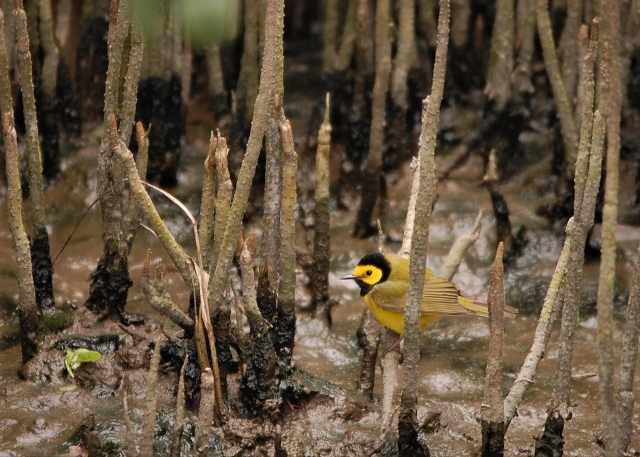by M. Kathy Raines

Fall migration is in full swing, and the charming little hooded warbler is resting and filling up on Valley insects as it journeys from the eastern U.S. to the tropics. A black hood, like Batman’s cowl, encircles the lemon-yellow face of the male, making it one of our most easily identifiable visitors.
The hooded warbler (Setophaga citrina) is certainly easier to observe than many of its kin, which flit from one green patch to another as a photographer twists and swivels, trying to capture them. When I first saw a hooded warbler, I feared it would dart away, but it hopped on the grass nearby as if planning to say hello. It prefers forest understory, and likely it was exhausted from its recent flight. I shot photo-after-photo. Once I learned its name, I have never failed to recognize this distinctive species, even though it wears the yellow and black so common to warblers.
Visiting as early as August, the hooded, black-and-white, and yellow warblers are among the first of the autumn migrants to make a stopover in the Rio Grande Valley, and fall migration may continue through late November. Autumn migrants arrive in a less dramatic, more incremental fashion than do those in our exhilarating April “fall-out”, when birds wintering in Central and South America appear to drop from the sky in droves to fatten up for the remainder of their voyage, often over the Gulf of Mexico.
Also, autumn migrants include more juveniles who, as adolescents embarking on their maiden journey south, may behave in a bolder, foolhardier, manner than do their more worldly parents. Identifying these juveniles—along with recognizing plumage of the often drabber females—presents birders with challenges.
Hooded warblers and their kin, though apparent miracles of navigation, sometimes do stray and become lost. In springtime, hooded warblers may overshoot, arriving too far north of their eastern U.S. nesting grounds, occasionally landing along the Canadian coast. Also, warblers face extreme hazards during migration, including unpredictable winds and storms.
The hooded warbler is one of 54 species of wood warbler, or parulid (in the family Parulidae, Latin for a “tit”, a tiny bird). Parulids include lively, usually thin-billed, vividly colored, insectivorous songsters which thrive in woodlands. This warbler’s genus name “Setophaga” means “moth-eater” in ancient Greek. (An older book may give its former genus, Wilsonia). Its species name “citrinus” comes from Latin “citrus”, meaning “lemon tree”, denoting the bird’s bright yellow color.
A male hooded warbler sports a quite distinctive, face-framing black hood, making identification a breeze for even novices. But the female’s hood is incomplete. Some older females’ hoods are nearly as dark as a male’s, but less glossy and distinct, and juveniles have a pale, incomplete hood. All these warblers, however, have large, dark eyes and tails which they habitually flick open, revealing outer white tailfeathers reminiscent of white flecks.
While local birders can observe migratory warblers among low, sparse trees and scrublands, this task proves more difficult for those searching for them in the denser woods of the birds’ nesting areas in the eastern U.S., including parts of East Texas. But avid birders also learn to recognize warblers by habits—hooded ones prefer forest understory, and their flight is strong and undulating—and by song.
A hooded warbler’s tune is a ringing, melodious variation on “ta-wit ta-wit ta-wit tee-yo”—its loudness and resonance typical of wood warblers who inhabit forest understory near streams. Its flight call, or chip note—used for locating, warning, or otherwise contacting one another—is a flat “chink”. Based on the warbler’s agitation levels, it alters in volume, speed and frequency. Though it may sing from treetops, this warbler usually stays low.
Feeding on trunks, boughs and the ground, hooded warblers may pick off grasshoppers, flies, beetles, spiders, and caterpillars from foliage. Sometimes they “hawk”, or, in bursts of flight, snag creatures on the wing. In their winter habitats in Mexico, Central and northern South America, each sex has its own distinct feeding area—males, in partially evergreen forests, females, in shrublands and brushy fields— and they both repel avian intruders, chipping out warnings. Wings spread and heads tucked, they hunch over and sway their heads from side-to-side. If aural and visual displays fail, the warblers will attack.
Hooded warblers breed within mixed hardwoods near streams in the Northeast and Midwest and in swamps and cypress wetlands in the South. The birds form pairs, but DNA tests reveal that both sexes stray from these bonds. The female builds a cupped nest of dried leaves, strips of bark and plant matter, lined with feathery plant down, spiderwebs, hair and moss in the fork of a two or three-foot high shrub or tree. She incubates three or four white, spotted eggs, which hatch after twelve days. Hatchlings are naked, blind and altricial, or unable to regulate body temperature. Both parents tend to the chicks for five weeks or so, and they fledge in about ten days. Parents feed them for four or five weeks as they master flying. Most pairs raise two broods a season.
Brown-headed cowbirds pose a serious problem for hooded warblers. Brood parasites, cowbirds lay their eggs in other birds’ nests, compelling these parents to raise cowbird chicks. Warbler parents will feed the much larger cowbird chicks, sometimes leaving their own to starve.
Hooded warblers are not endangered. However, we must look out for them. Ballooning housing developments fragment the uninterrupted woodlands they require for breeding, wintering and resting during migration. And deforestation in the tropics threatens to destroy their winter territories. Cowbird parasitism worsens in fragmented forests. Finally, an overabundance of browsers—deer, feral cats, dogs, crows and jays—disrupts their habitat.
